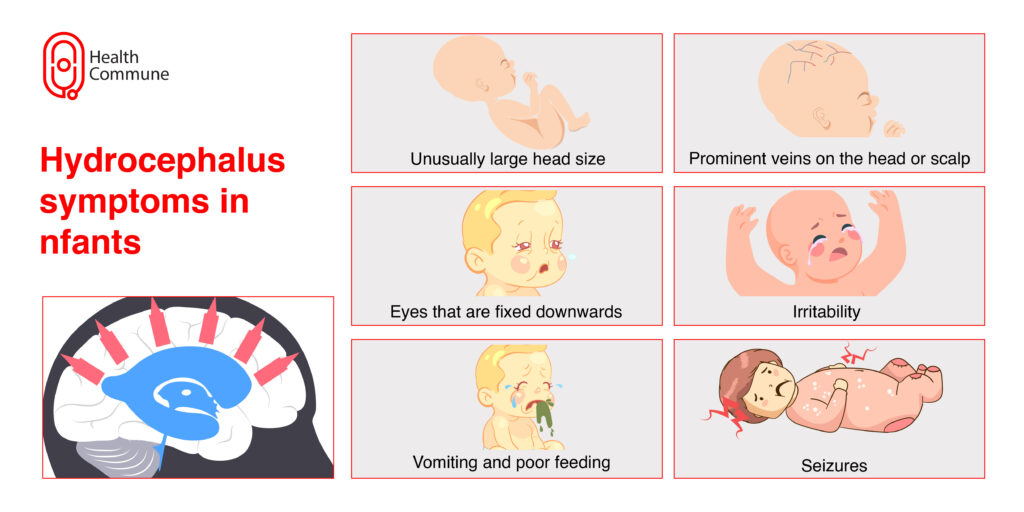What is hydrocephalus?
What are the causes of hydrocephalus?
Based on its causes, it can be classified into :
- Congenital hydrocephalus: This type of hydrocephalus is present from birth. It is seen in newborns and could be due to abnormal development of the nervous system, infections during pregnancy or birth defects
- Acquired hydrocephalus: This can develop after birth or in adulthood and is caused by head trauma, bleeding, tumours, cysts or infections such as meningitis (post-meningitic hydrocephalus is commonly seen in India)
- Communicating hydrocephalus: This is caused due to either overproduction or decreased absorption of CSF. There is no obstruction to its flow in the ventricles
- Non-communicating or obstructive hydrocephalus: This happens when the flow of CSF is blocked
- Normal pressure hydrocephalus: This is seen in people over 60 years old . The pressure increases slowly over time and causes the ventricles to dilate. This can develop as a result of stroke, injury, infection, surgery, or haemorrhage
- Hydrocephalus ex-vacuo: In this, the brain tissue shrinks due to damage to the brain because of a stroke, traumatic injury or conditions like Alzheimer’s disease and other dementias
Generally, hydrocephalus is more prevalent in low- and middle-income countries with Africa and Latin America having the highest rates of incidence, while countries such as the USA and Canada have among the lowest rates.

What are the symptoms of hydrocephalus?
The following changes are seen in infants :
- An unusually large head size, a sudden increase in the head size or a bulging or tense soft spot at the top of the head
- Prominent veins on the head or scalp
- Eyes that are fixed downwards
- Irritability
- Vomiting and poor feeding
- Seizures
In children and adolescents :
- Poor appetite
- Nausea and vomiting
- Headache
- Blurred or double vision
- Seizures
- Urinary incontinence
- Delay in school performance
- Personality changes
- Irritability
- Loss of developmental progress
In adults :
- Headache
- Nausea and vomiting
- Lethargy
- Loss of coordination or balance
- Loss of bladder control or
- Impaired vision
- Decreased memory, concentration, and other thinking skills
In the elderly population :
- Memory loss or mild dementia
- Impaired vision
- Increased urge to urinate
- Loss of balance and poor coordination
- Difficulty in walking
Can hydrocephalus lead to any complications?
Complications depend on the severity of symptoms, the underlying cause and how soon treatment is started after diagnosis.
The long-term complications are difficult to predict and can vary widely. In cases where it is congenital, it can lead to significant intellectual and developmental disabilities.
How is hydrocephalus diagnosed?
Your doctor can diagnose this condition based on your symptoms and the results of the physical examination. They will do a thorough neurological examination to determine the severity of the condition. Additionally, you can be asked to get an ultrasound, CT, or MRI scan.
How is hydrocephalus treated?
Hydrocephalus requires surgery, which can be done either to divert the excessive CSF away from the brain or remove the obstruction.
- Shunt: A long tube is inserted along with a valve and a catheter to divert the excess fluid away from the brain and into the abdomen. This shunt is required for life
- Endoscopic third ventriculostomy: A small video camera is used to look inside the brain and look for alternate routes to help the excessive CSF flow out of the brain
What follow-up is required after surgery?
Your doctor will do a neurological exam post-surgery. A follow-up ultrasound, CT or MRI may also be required. Contact your doctor immediately in case of :
- Skin changes around the incision
- Fever
- Headache or double vision
- Nausea and vomiting
- Irritability
Can hydrocephalus be prevented?
While it cannot be prevented altogether, you can :
- Safeguard yourself against infections by getting vaccinated as per the recommended schedule
- Promptly get treated for any kind of infections
- Reduce your chances of a head injury by using appropriate safety equipment such as seat belts, child safety seats ,and bike helmets





